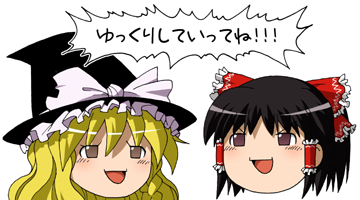White papers
Anime Girls in Bullet Hell
Everyone, meet Cirno.

This pretty little lady is an ice fairy, has her own lakeside real estate, hates frogs, is only around 60 years young, and is known to be called an idiot. She is one of the characters in the Japanese video game franchise Touhou Project.
What's a Touhou?
Also known as Project Shrine Maiden, The Touhou Project (東方 Project) is a Japanese indie game series focused on bullet hell shooting arcade, created by the one-man developer Team Shanghai Alice.

As you can see in the screenshot, Touhou gameplay is quite similar to that of classic "shoot 'em up" arcades like Space Invaders and Raiden. You're playing as the little girl (indicated with red dot) at the bottom of the screen and if you touch anything else in the field, you die. Simple.
Shoot'em Up & Bullet Hell Genres
"Bullet Hell" video games are on the upper echelon in the Japanese gaming scene requiring lightning quick reflexes and the ability to maneuver through countless patterns of bullets to prevent death. These games are also dirt cheap to produce since they are not very graphically intensive and can be ported to either Windows or older existing arcade or console game hardware with ease. Actually, the Touhou series is programmed entirely by one man who goes by the name ZUN. While not much is known about him, he is a former employee of the Japanese game developer Taito Corporation who apparently began creating Touhou games to get beer money.

Now, all but a few of the characters can be identified as being rooted or inspired at some level by folklore be it Japanese or otherwise and are commonly referred to as youkai. We are talking fairies, devils, witches, ghosts, that kind of thing. The characters appear as either the character you play as or bosses of levels and are all intertwined with each other in terms of storyline and relationships, but we can go on for days talking about that. The real question at hand is how do they meme so well?
It's so "Moé"
To better understand the story behind marriage of anime girls and side-scrolling shooter games, it will be helpful to acquaint ourselves with a Japanese slang word / concept known as moé. Often thrown around in the Otaku circles in Japan and overseas, "moé" has been used by hardcore anime fans to describe feelings of infatuation towards a hobby, or in this case an anime character.
The unique character designs seen in the Touhou series provides major attraction for the Japanese Otaku community interested in moé anthropomorphism, spawning hybrid characters, additional back stories, flash animations, comic strips, MADs, cosplay, the list goes on. Urban Dictionary has multiple definitions that make a good attempt at defining the term.

These are yukkuri, also known as an instance of Touhou fanart FAIL which has grown into its own off-hoot trend of disembodied, badly-drawn anime heads.
BGM Soundtrack: I've Heard This Song Before…
The music featured in the Touhou games are also popular remix points, especially on the Japanese video-sharing site Nico Nico Douga. The biggest Touhou music meme being, hands down, Ran Ran Ru AKA Ronald McDonald Insanity.
This video is actually a remix of the theme song for Touhou character Flandre Scarlet mashed with Japanese McDonald's commercials. The track, titled U.N. Owen Was Her?, is one of the more popular songs featured in the series and has even leaked into other Nico Nico Douga fads such as its own Automatic Mario remix ("video link"::https://www.youtube.com/watch?v=zt8upKaWzy0) among other things.
Touhou Comes to America
Bad Apple!! is also considered one of the most well-known Touhou music tracks, which became the subject of a viral Japanese music video showcasing the who's who in the world of Touhou. However, the popular phenomenon was first introduced in the English-speaking mainstream media through CNN's web trend report on the "Bad Apple!!" video going viral:
Can It Be Stopped?
Comiket (a.k.a Comic Market) is the world's largest fair for self-published comics also known as doujin. The three-day long event is held twice every year and attendance has begun to hit the half million mark in Japan. Many of the artists selling their doujin artworks are amateur illustrators who produce content related to and based on characters of their respective fandoms. In the past few years, however, Touhou fandom has seen a dramatic rise. In the graph below, numeric data at the bottom indicates the total number of Comiket events organized while the number on the left indicates how many groups attended selling Touhou-related fan goods.

More recent data from a self-published comic retailer in 2009 shows that Touhou-related material now floods over 40% of the retail fan created merchandise market. This doesn't even consider all of the artists, musicians, figure and toy makers, and all of the other means of moé transmission being sold independently away from the retail market and online.

Another thing to consider is that with many doujin works, the merch in question is not officially recognized. It does add a remix spin on the otaku culture as they are willing and able to fill the consumerist void with their own products when the fan desire to purchase outweighs the supply.
Point of Reference: Team Fortress 2

Given the extensive development of Touhou and ambiguous nature of "moé" in Japanese, there are lots of things to grasp for English-speaking gamers that are just entering the booming scene. However, such strong appeals of fandom mentality and personal attachment to custom-designed characters have been similarly observed in Western videogame culture as well, most notably with the American-made first person shooter Team Fortress 2.
For more information, please read KYMdb – Touhou Project and Touhou Wiki.

Comments ( 36 )
Sorry, but you must activate your account to post a comment.